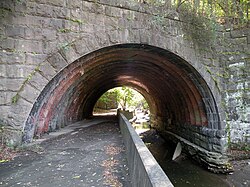
Bear Run is a 5.0-mile-long (8.0 km) tributary of the Youghiogheny River in Fayette County, Pennsylvania, in the United States.

Larrys Creek is a 22.9-mile-long (36.9 km) tributary of the West Branch Susquehanna River in Lycoming County in the U.S. state of Pennsylvania. A part of the Chesapeake Bay drainage basin, its watershed drains 89.1 square miles (231 km2) in six townships and a borough. The creek flows south from the dissected Allegheny Plateau to the Ridge-and-valley Appalachians through sandstone, limestone, and shale from the Devonian, Mississippian, and Pennsylvanian periods.

Anderson Creek is a 23.6-mile-long (38.0 km) tributary of the West Branch Susquehanna River in Clearfield County, Pennsylvania, in the United States.

The Casselman River is a 56.5-mile-long (90.9 km) tributary of the Youghiogheny River in western Maryland and Pennsylvania in the United States. The Casselman River drains an area of 576 square miles.

Chartiers Creek is a tributary of the Ohio River in Western Pennsylvania in the United States. The creek was named after Peter Chartier, a trapper of French and Native American parentage who established a trading post at the mouth of the creek in 1743.

Jacobs Creek is a 33.4-mile-long (53.8 km) tributary of the Youghiogheny River beginning in Acme, Pennsylvania and draining at its mouth in the town of Jacobs Creek into the Youghiogheny River. Jacobs Creek is the southwestern border of Westmoreland County and the northwestern border of Fayette County. The area was a major producer of rye whiskey in the decades before Prohibition.
The Little Saw Mill Run Railroad was a 4 ft 8+1⁄2 instandard gauge coal railroad in Allegheny County, Pennsylvania. It was incorporated July 23, 1850, and opened in April 1853. Originally, it was owned by the Harmony Society, and ran from Temperanceville, Pennsylvania on the Ohio River to Banksville, Pennsylvania, running parallel to Saw Mill Run and Little Saw Mill Run. In an agreement with the 3 ft narrow gauge Pittsburgh Southern Railroad, it ran dual gauge tracks. It became part of the railroad empire of George J. Gould, merging with the West Side Belt Railroad in 1897. The superintendent of the Marine Railway at Sawmill Run for 13 years was Captain Edward Boland.
Streets Run is a 5.2-mile-long (8.4 km) tributary of the Monongahela River in Allegheny County, Pennsylvania. This urban stream drains portions of the communities of Pittsburgh, Baldwin, Brentwood, West Mifflin and Whitehall, an area of about ten square miles.

Buffalo Creek is a stream in the U.S. states of Pennsylvania and West Virginia. It rises in East Finley Township, Washington County, Pennsylvania. Its tributaries are Brushy Run, Mill Run, Indian Camp Run, Buck Run, and Dutch Fork. These streams flow through the townships of East Findley, Donegal, Hopewell, and Buffalo, and the creek itself empties into the Ohio River at Wellsburg, West Virginia. The stream was presumably named for a Buffalo trace that once passed through the valley.

South Branch French Creek is a 24.2-mile (38.9 km) long tributary to French Creek in Erie County, Pennsylvania. It is classed as a 3rd order stream on the EPA waters geoviewer site.

Quebec Run is a 3.74 mi (6.02 km) long 3rd order tributary to Big Sandy Creek in Fayette County, Pennsylvania. This is the only stream of this name in the United States.
Tebolt Run is a 3.46 mi (5.57 km) long 2nd order tributary to Big Sandy Creek in Fayette County, Pennsylvania. This is the only stream of this name in the United States.
Little Conneauttee Creek is a 14.27 mi (22.97 km) long 3rd order tributary to Conneauttee Creek in Crawford County, Pennsylvania and Erie County, Pennsylvania. This is the only stream of this name in the United States.
Darrows Creek is a 4.80 mi (7.72 km) long 3rd order tributary to Conneauttee Creek in Erie County, Pennsylvania. This is the only stream of this name in the United States.
Torry Run is a 5.83 mi (9.38 km) long 2nd order tributary to Conneauttee Creek in Crawford County, Pennsylvania and Erie County, Pennsylvania. This is the only stream of this name in the United States.
West Branch Cussewago Creek is a 5.55 mi (8.93 km) long 2nd order tributary to Cussewago Creek in Crawford and Erie Counties, Pennsylvania. This is the only stream of this name in the United States.
Castleman Run is a 7.54 mi (12.13 km) long 3rd order tributary to Buffalo Creek in Brooke County, West Virginia. This is the only stream of this name in the United States. Castleman Run Lake, an impoundment of this stream, is protected as Castleman Run Lake Wildlife Management Area by the State of West Virginia.
Laidley Run is a 3.16 mi (5.09 km) long 2nd order tributary to Middle Wheeling Creek in Ohio County, West Virginia. This is the only stream of this name in the United States.
Kratzer Run is a 5.75 mi (9.25 km) long 3rd order tributary to Anderson Creek in Clearfield County, Pennsylvania. This is the only stream of this name in the United States. Kratzer Run is the largest tributary to Anderson Creek and drains a region of farmland and places that have been surface mined for coal. As a result, Kratzer Run suffers from Acid Mine Drainage (AMD) and the impact of adjacent highways and communities is considered the most degraded tributary to Anderson Creek. Bilger Run, a tributary, is also impaired by AMD. Numerous places of erosion have been noted as well. In spite of the impacts, numerous efforts are underway to mitigate the pollution.

Bilger Run is a 5.05 mi (8.13 km) long 2nd order tributary to Kratzer Run in Clearfield County, Pennsylvania and Kratzer Run's largest and only named tributary. Its watershed accounts for nearly half of the greater Kratzer Run watershed. This is the only stream of this name in the United States. Bilger Run has an ID number of 1169617 from the US Board of Geographic Names.












